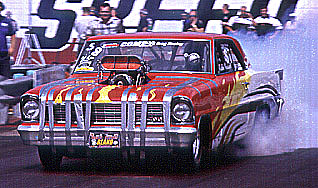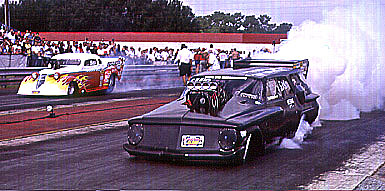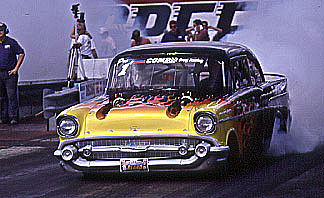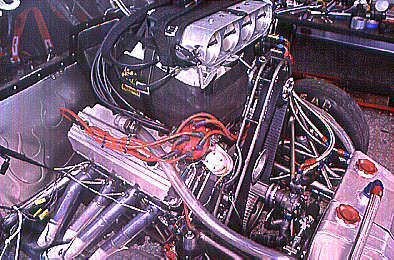|
 Both
of the "Street Legal" sanctioning bodies (NMCA and NSCA) name "World"
Champions in all of their classes. Each sanctioning body has different
rules for classes with the same name. It's getting as bad as professional
wrestling or boxing, with so many "World Champions" that none of them
are really World Champions in the mind of the fans of the sport. There
is, however, at least one race where a majority of the "hitters" from
both organizations show up and race under the same set of rules to see
who is the baddest. Both
of the "Street Legal" sanctioning bodies (NMCA and NSCA) name "World"
Champions in all of their classes. Each sanctioning body has different
rules for classes with the same name. It's getting as bad as professional
wrestling or boxing, with so many "World Champions" that none of them
are really World Champions in the mind of the fans of the sport. There
is, however, at least one race where a majority of the "hitters" from
both organizations show up and race under the same set of rules to see
who is the baddest.
For eight years Carl Weisinger's World Street Nationals held at his
Orlando Speed World track has been that race. The rules for each class
are simple, fair and easily enforceable, and the payouts for every class
are among the highest anywhere.
At many street car racing events short fields in the top two or three
classes make qualifying a ho-hum affair where the racers just go through
the motions until race day. After all, if everybody gets to race on
Sunday what is the point of beating up your equipment?
That is certainly not the case at the World Street Nationals where
every class had enough serious racers trying to make the show that qualifying
in the top classes reminded this reporter of the old days of Top Fuel
when 50 cars would show up for a sixteen car field. Unlike other street
legal races, this event had three days of qualifying consisting of four
laps with the final qualifying session coming on Sunday morning before
the first round of eliminations.
If you liked the old days where every qualifying lap was an all-out
effort and the pits resembled a war zone as crews thrashed all night
to be ready for the next lap, this race is for you.
 Super
Pro Street is the top class at this event in terms of drivers, budgets,
equipment and performance. The rules are simple: slicks, unlimited cubic
inches, stock appearing bodies, working horns, working lights, and mufflers.
This is no "cookie cutter" class. Every kind of engine and body combination
in street racing could be found in the pits. Super
Pro Street is the top class at this event in terms of drivers, budgets,
equipment and performance. The rules are simple: slicks, unlimited cubic
inches, stock appearing bodies, working horns, working lights, and mufflers.
This is no "cookie cutter" class. Every kind of engine and body combination
in street racing could be found in the pits.
If you like turbocharged cars there was Bob Rieger's '57 or Chuck Samuel's
Chevy truck. If you prefer supercharging there was Steve Hall's '51
Mercy or Todd Shepherd's '62 Hemi wagon. You a nitrous guy? Pat Musi's
99 Pontiac or Tony Christian's '57 Chevy was for you. And there was
more, much more. Twenty-nine cars, most of them weighing around 3000-lbs
made laps trying to make the 16-car field.
 Qualifying
was led by 2000 NMCA Pro Street champ Bob Rieger driving his turbocharged,
430 cubic inch small-block powered '57 Chevy. On Sunday morning Rieger
ripped off a 6.758/209.20 to get the pole. NSCA Pro Street National
Champ Pat Musi qualified his mountain-motored, nitrous oxide injected,
'99 Camaro a tick behind Rieger with a 6.760/206 and the third spot
was held down by NMCA Outlaw Street champ Marc Dantoni with a 6.84. Qualifying
was led by 2000 NMCA Pro Street champ Bob Rieger driving his turbocharged,
430 cubic inch small-block powered '57 Chevy. On Sunday morning Rieger
ripped off a 6.758/209.20 to get the pole. NSCA Pro Street National
Champ Pat Musi qualified his mountain-motored, nitrous oxide injected,
'99 Camaro a tick behind Rieger with a 6.760/206 and the third spot
was held down by NMCA Outlaw Street champ Marc Dantoni with a 6.84.
Super Pro Street qualifying was a war. Rieger never got down the track
until his last qualifying effort. Musi reportedly swapped engines between
laps, running his 650-inch combination and then switching to a 707-inch
motor to try and better his time. Marc Dantoni may have damaged some
pistons early in qualifying and had to tiptoe through eliminations.
How tough was it to make the 16 car field? Well, former NMCA World
Champ Randy Adler and Annette Summer, who has won both NSCA and NMCA
World Championships, were watching instead of racing on Sunday unable
to run quicker than the 7.051 bump recorded by New Jersey racer Eddie
Cassatt.
 Three-time
World Street winner Tony Christian was gone in the first round and two
time winner Mike Moran red-lighted against Jeff Miller's supercharged
'37 Chevy in the second round. Number two qualifier Pat Musi also took
an early exit, losing to Hank Hill's naturally aspirated 800 inch Ford
Thunderbird in the second round. Three-time
World Street winner Tony Christian was gone in the first round and two
time winner Mike Moran red-lighted against Jeff Miller's supercharged
'37 Chevy in the second round. Number two qualifier Pat Musi also took
an early exit, losing to Hank Hill's naturally aspirated 800 inch Ford
Thunderbird in the second round.
Rieger's turbo '57 ran consistent 6.80s on his way to a final round
matchup with 2000 NMCA Outlaw Street champ Marc Dantoni's nitrous oxide
assisted '97 Monte Carlo.
The final was a little anti-climatic as the anticipated showdown between
the turbocharged car and the nitrous car never materialized. Rieger
lost the critical lane choice in the semis by .013 of a second to Dantoni
and could only deliver a sub-par 7.11/176 to Dantoni's winning 6.782/208.76
in the left lane. The lap was not only Dantoni's best E.T. and speed
of the event but it also got Staten Island, New York racer the $10,000
first prize money.
Pro Street DOT only had 18 cars entered. The class rules are similar
to the Super Pro Street class with the exception of DOT legal rear tires
being required. The facts that hooking up the DOT rear tires is very
tricky and that the Pro Street DOT winner got half of what the Super
Pro Street winner did may have contributed to the lack of entries.
Brian Robbins' radically chopped '67 Nova, which regularly races in
the NMCA DOT tire class, was the dominant car at this event. Using supercharged
Chevy power Robbins qualified number one with a 6.990/202.20. The little
Nova also set low E.T. and Top Speed of the meet with a lap of 6.938
and a speed of 203.02.
|